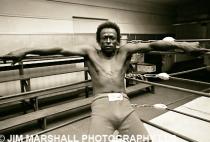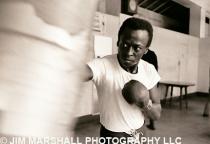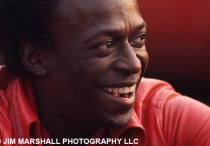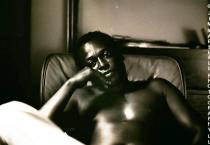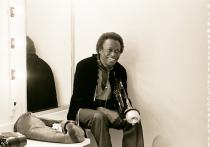“I’m always thinking about creating. My future starts when I wake up every morning ... Every day I find something creative to do with my life.” — Miles Davis
Continuing with our focus on Jim’s work with Miles Davis, we now bring you the heavy hitters, leading off with one of my all-time favorite of Jim's photos: Miles in the Ring or as Jim sometimes referred to it: Don’t Hit Me in the Mouth, I Gotta Play Tonight, which was apparently what Miles would tell his sparring partners at Newman's Gym before they tussled. Why do I love this shot so much?
1. The setting, Newman’s Gym, in 1971 and the fact that Miles would let Jim, or ANY photographer, shadow him during his workouts, which he viewed as sort of a sacred part of his regimen. And a boxing gym in the Tenderloin? For me, whose grandpa boxed Golden Gloves, I’m not sure there’s anything cooler.
2. The way Jim captures the combative side of Miles ... somehow it’s not so surprising that Miles was a devotee of the sweet science. Boxing, especially back in the day, was a combo of deft, swift and lethal talents, something that Miles' playing and Jim's approach to capturing his subjects had in common.
3. After Jim and I split up and I was in NYC I had a fairly serious (for 23) beau, Matt Goldenberg; I was serious enough about him to tell Jim, who still carried a major torch in my general direction (he was nothing if not tenacious). Matt was a big jazz aficionado and fan of Jim’s work and secretly coveted a shot of Miles in the Ring … and Jim gave him one. Even though Matt and I didn’t last, I like to think that shot still graces his wall, a small testament to the fact that Jim could be a very classy guy … as long as you had his trust.
Isle of Wight Festival
I also love the color shots of Miles at the ground-breaking Isle of Wight music festival in 1970, especially the shot of Miles grinning (pictures of a genuinely happy Miles are so rare!) Here's more from Wikipedia on the festival's historic status: The 1970 event was by far the largest and most famous of these early festivals; indeed it was said at the time to be one of the largest human gatherings in the world, with estimates of over 600,000, surpassing the attendance at Woodstock. Included in the line-up of over fifty performers were The Who, Jimi Hendrix, Miles Davis, The Doors, Ten Years After, Emerson, Lake & Palmer, Joni Mitchell, The Moody Blues, Melanie, Donovan, Free, Chicago, Richie Havens, John Sebastian, Leonard Cohen, Jethro Tull, Taste and Tiny Tim. The unexpectedly high attendance levels led, in 1971, to Parliament passing the "Isle of Wight Act" preventing gatherings of more than 5,000 people on the island without a special license.
The 1970 festival was filmed by a 35mm film crew under the direction of future Academy Award-winning director Murray Lerner, who at that point had just directed a documentary on the Newport Folk Festival. Lerner distilled material from the festival into the film A Message to Love: The Isle of Wight Rock Festival released theatrically in 1996 and subsequently on DVD. Check out this great video of Miles and his amazing band playing "Call it Anything" live at the festival.
The Full Story of How Jim Got to Miles
And, for those of you keeping score, I had time to dig just a bit deeper on the “interwebs” and found the story of Jim finally getting through to Miles and earning his trust in Jim’s own words on the NPR jazz blog:
“I first photographed Miles Davis in 1959, but not too well. I remember after a show in Berkeley, California, a little later around 1960, I went up to him backstage and asked why he had a green trumpet. He shot back at me, ‘M—————r, do I ask you why you have a black camera?!’ Frightened the s—- outta me for the next five years! After I moved to NY in 1962, I did a couple of covers for Miles, live records on Columbia. I went down the first time he played for Bill Graham at Winterland in San Francisco. I had made him a picture of my John Coltrane photo that I had taken in John’s garden. Backstage was crazy.
“He was surrounded by all the media, press, local TV stations and newspapers ... it was a real big deal. I saw him and said, ‘Hey Miles’ he sort of grunted and acknowledged my presence. I gave him the print and said, ‘This is for you.’ ‘What is it? I’m busy.’ ‘It’s just something for you.’ ‘I'm busy,’ he says again. I walked away and he opens the package. People are all over him, asking questions, bothering him and trying to get to him, he tells them all to shut the f—- up and leave him alone. “He’s looking at the print. He loved Coltrane. ‘Hey Marshall, did you take this of John? You knew him like that? Why don’t you take pictures of me like this?’ And I said, ‘Why don’t you let me?’ After that I could do whatever I wanted with him. He had his moods but we were cool. It was trust. If John trusted me, then so did Miles and with trust I got great shots of him.”
- Jim Marshall Photography LLC Newsroom blog
- Log in to post comments
